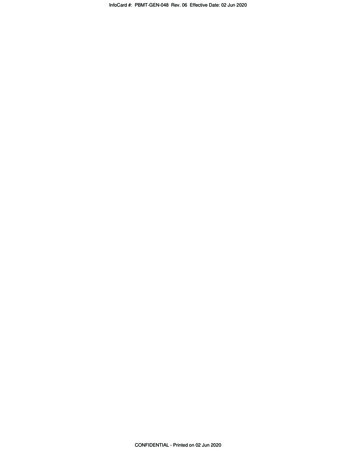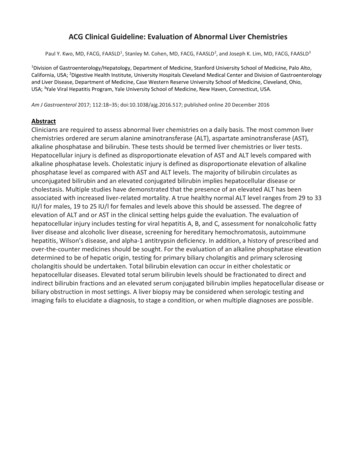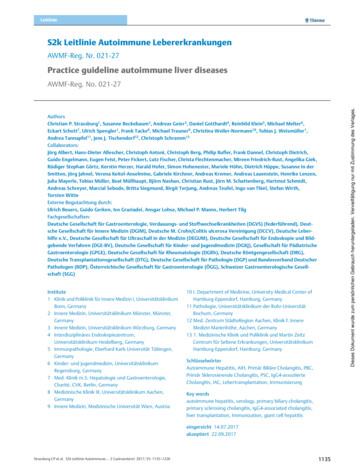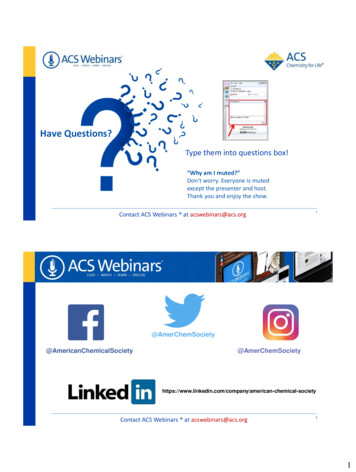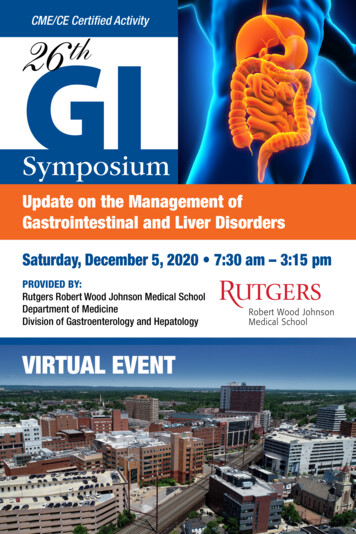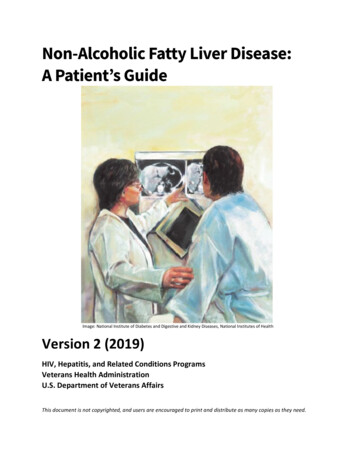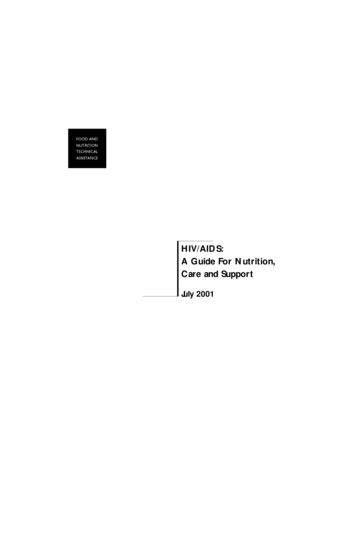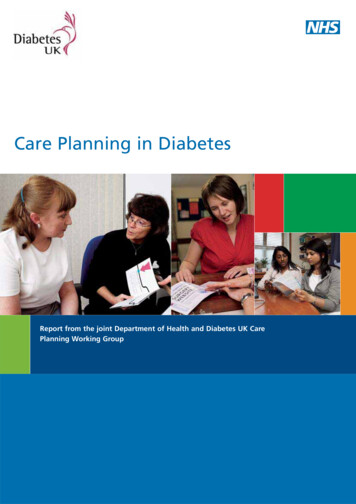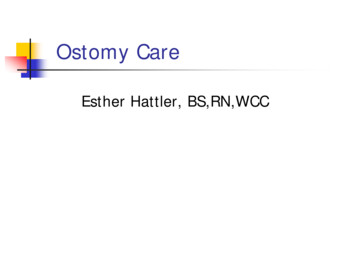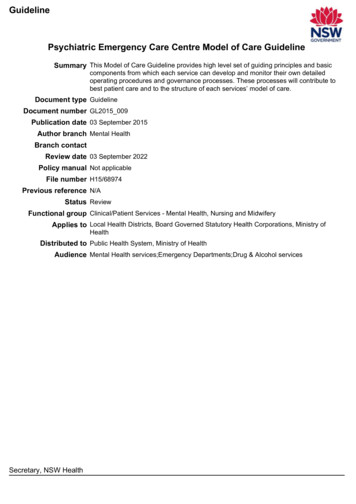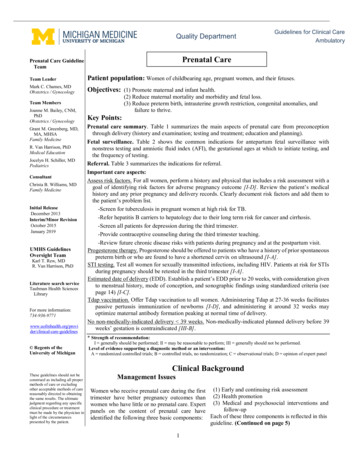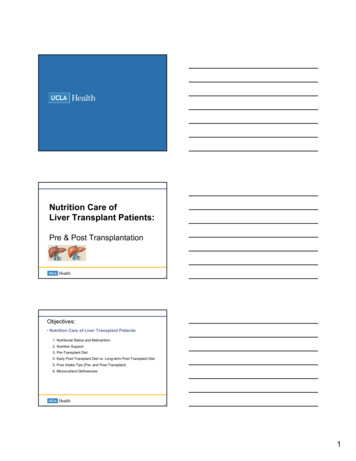
Transcription
Nutrition Care ofLiver Transplant Patients:Pre & Post Transplantation2Objectives: Nutrition Care of Liver Transplant Patients1. Nutritional Status and Malnutrition2. Nutrition Support3. Pre-Transplant Diet4. Early Post-Transplant Diet vs. Long-term Post-Transplant Diet5. Poor Intake Tips (Pre- and Post-Transplant)6. Micronutrient Deficiencies31
1.Nutrition Status and Malnutrition4Prevalence of Malnutrition in Liver Disease Current estimates are 15-60% 90% of pts with cirrhosis 20% of compensated cirrhosis cases 50% of decompensated cases 57% of cirrhotic inpatients had malnutrition during their admission Every patient with alcoholic hepatitis/cirrhosis has malnutrition of varying severity 62% alcoholic subjects without liver disease were observed to have malnutrition 65-90% of patients with advanced liver disease suffer from malnutrition 55% of patients with ESLD BMI 30-40 have sarcopenia determined on CTWhy Malnutrition in Liver Disease? Inadequate nutrient intake: Loss of appetite, early satiety, delayed gastric emptying,bloating, abdominal distention, decreased alertness, N/V/D,restrictive diets, altered taste perception - linked to zincdeficiency Metabolic alterations: Altered glucose, lipid and protein metabolism, energyconsumption, decreased glycogen levels, reduced storage ofnutrients Malabsorption/maldigestion: Bile salt deficiency, small bowel bacterial overgrowth, portalhypertensive enteropathyPimentel et al., MCNA 2016Mouzaki et al. JPEN 20142
Two Main Factors Contributing to Malnutrition: Semi-starvation Inadequate intake Increased requirements Impaired absorption Altered transport Altered nutrient utilizationSystemic inflammatoryresponse Inflammation Hypermetabolic state Hypercatabolic stateJensen et al., JPEN 2009Patel et al., NCP 2017Malnutrition is Associated with the Following Increased risk of pressure ulcersImpaired wound healingImmune suppressionIncreased infection rateMuscle wastingFunctional lossIncreased LOSHigh readmission ratesHigher treatment costsIncreased mortalityTappenden et al., JAND RiskIdentifiedInflammation Present? No/YesNOStarvation RelatedMalnutritionMarasmusYESMild to ModerateDegreeChronic ammatoryResponseAcute Disease orInjury‐RelatedMalnutritionPEUJensen et al., JPEN 20103
Why Albumin and Prealbumin are AbsentInflammationPositive acute-phase reactants:Increased C-reactive protein, fibrinogen,procalcitoninNegative acute-phase reactants:Decreased visceral proteins: albumin,prealbumin, transferrin Proxy measure for underlying disease burden and inflammatory condition Liver dysfunction and reduced synthesis of proteins Prealbumin has a shorter half-life than albumin but same issues Identifying the degree of inflammation is necessary Alb / prealb can be useful in absence of inflammation with adequate nutritionWhite et al., JPEN 2012Patel et al., NCP 20172. Nutrition Support11Benefits of Enteral Nutrition Nutrition benefits of EN: Calories, protein, micronutrients and antioxidants Substrate for protein synthesis Supporting cellular and mitochondrial function Non-nutrition benefits of EN: GI: gut integrity, reduce inflammation, motility/contractility,absorptive capacity, maintaining GALT mass/beneficialbacteria, trophic effect on epithelial cells, reduced virulence Metabolic: insulin sensitivity, reduce glycosylation, fuelutilization Immune: maintain MALT, modulate adhesion molecules andkey regulatory cells, anti-inflammatory effectsHasse and Gautam, 20174
Popular Enteral Formulas Peptamen 1.5 with prebio (replaced Peptamen 1.5) Well-tolerated,concentrated formula while on CRRT Nepro Concentratedformula with lower level of electrolytes for SPHD Peptamen AF Well-tolerated,high-protein, anti-inflammatory formula TwoCal HN Mostconcentrated formula, higher in fat Vital High Protein Veryhigh protein, isotonic- great for trickle feeds or trial of TF13Modular Enteral Products Fiber Additive: Nutrisource Fiber: 1 or 2 scoops Protein Additive: Beneprotein: 1 or 2 scoops Shouldnot be added to tube feeding bag Require Eachflushing before and after to reduce risk of clogging tubeadministration should be documented in Care Connect Flowsheets:FEEDINGDaily Cares tab: row below NUTRITION and above TUBETube Feeding Administration:Mix scoop of powder with (60-120 mL) water until dissolved. Administer by syringe throughfeeding tube. Flush afterwards with a minimum of 30-60 mL water. Do not put additives in tubefeeding bag.Oral Administration:Stir scoop of powder into at least 4oz of any warm or cold beverage or soft food, includingpuree. Stir until dissolved. Avoid mixing into acidic liquids like orange juice, sodas or lemonade.14Barriers to Adequate Enteral Nutrition Delays in ordering EN Waiting on tube placement or calorie count results Initiation at low rate or stuck at trickle feed rate Trickle feed 360 kcals/day, hypocaloric feed 1600 kcals/day Rate advanced too slowly Held too frequently Held for GI bleed and variceal banding. Restart EN in 24-48 hours after GI bleed stops Held for elevated gastric residual volumes (GRVs) Post-pyloric tubes recommended for HE and delayedgastric emptying Stopped too soon, patient not eating 50% of all mealsHasse and Gautam, 20175
Parenteral Nutrition (PN) Guidelines2016 SCCM/ASPEN Guidelines for the Provision andAssessment of Nutrition Support Therapy in AdultCritically Ill Patient recommends:1. No PN for first 7 days in ICU for well-nourished patients2. PN upon admission to ICU for severely malnourished patientsa. Provide hypocaloric (20 kcal/kg or 80% of energy needs) x 1week3. No lipids for first week in ICUa. Or limit 100 gm per week if concern for essential fatty aciddeficiency (typically occurs in 3 weeks of inadequate EFAs)Improved safety of PN: improved glycemic control, avoidoverfeeding, use standard PN products and CVC care.McCleary et al., NCP 2016McClave et al., JPEN 2016Parenteral Nutrition Best Practices1.2.3.4.Use insulin to keep BG 140/150-180 mg/dLDextrose infusion rates 4 mg/kg/minProvide at least 1.2 gm protein/kgDetermine lipid use on individual basisa. Avoid EFADb. Utilize SoyMctOliveFish (SMOF) lipids when indicated5. Patients with cirrhosis often need:a. Additional thiamine, folate, zinc and less copper6. Give IV thiamine (Vitamin B1) prior to starting PNMcCleary et al., NCP 20162. Diet for Liver Disease (Pre-Transplant)186
Diet for Pre-OLT or Liver Disease Nutrition Goals: 35-40 Nokcal/kg (Adjusted / dry / ideal / actual body weight)protein restriction one of the causes of malnutrition (high protein) Highrisk of hypoglycemia (less glycogen stored / gluconeogenesis) Avoid Latefasting 3-6 hrs during day; small, frequent meals through dayevening snack with 50gm complex carbs for LBM retention To prevent or slow the advancement of liver disease: Maintaina healthy weight Avoidalcohol Avoidexcess iron intake (if iron blood level is in normal range)Anastacio et al., World J Gastroenerol 2016Amodio et al., Hepatology 2013Tsien et al., Hepatology 201519UCLA Diet Orders Low potassium diet: menu also low in Phos and Na 2 gram sodium diet: on low fat menu 1000 mg phosphorous diet: may not be necessary Carbohydrate controlled diet: grams of carb on menu Mechanical soft diet: cut up and soft foods for dentition Thickened liquids: unpalatable, risk of dehydration Puree diet: premade foods Fluid restriction: 1L, 1.5L- can reduce nutrition intake Coffee,juice, milk, ice cream, soup, gelatin, popsicles, sherbetand oral nutritional supplements (ONS) like Nepro, Ensure count20Well-documented Calorie Counts HelpCalorie Count Best Practices: All meal receipt slips marked with amount after every item: Choices: None, ¼, 1/3, ½, ¾, All All missed meals/snacks denoted and include why Any other non-meal foods on Caloric Intake Form1.Outside foods brought in (or ordered in)2.Snacks between meals, from UCLA or family3.Oral Nutrition Supplement (ONS) drinks4.Anything else consumed between/as meals217
Examples of Appropriate Meal Intake PercentagesModified from Abbott Nutrition, Accessed llin et al., GI and Liver Disease, 2012ACS Guidelines on Nutrition for Cancer Prevention234. Early Post-Transplant Dietvs. Long-term Post-Transplant Diet248
Post-Operative Nutrition Ideal: Clears / Diet for PONV vs. TF (if malnourished) 12-24 hrs, if stable Common: Stable / extubated / await bowel function / safe to swallow ? UCLA diet order options after advancement from Clears LowPotassium: (until K trends 5.0) Thismenu is also low phos and low sodium Carbohydrate this 2Controlled: (if on insulin post-op)menu is also low salt/fat– RD can liberalize if neededGram Sodium: Typicallynot unless post-transplant ascites, excessive fluid retention Mechanical IfSoft / Pureed: (Texture-dysphagia, per SLP)patient has not had a recent swallow eval for upgrades – ask!If patient not meeting 60% estimated goal in 1st week - add TF!25Transplant Food Safety Menu InsertDoes the patient / family have a copy of theTRANSPLANT FOOD SAFETY MENU INSERT?Obayashi, NCP lnessContaminants/UCM312793.pdf Accessed 7/11/201826Food Safety Review - Post-OLTThe following tips will lower the risk of foodborne illness.1. Wash hands well and frequently with soap and waterBefore handling foods and especially after handling pets, garbage,gardening, using the restroom and between handling raw and cookedfoods.2. Do not eat raw or undercooked meat, fish, poultry or eggsThis includes: sushi, ceviche, steak tartare, raw cookie dough, Caesarsalad dressing prepared with raw eggs, raw milk and cheeses madewith raw milk. Undercooked shellfish is especially dangerous for liverpatients. Runny egg yolks (over-easy) okay if using pasteurized eggs( UCLA).3. Defrost frozen foods in the refrigerator or in the microwaveNot on the counter or in the sink. Do not refreeze defrosted, uncookedfoods (okay to freeze after cooking). Families should practice at home.Obayashi, NCP lnessContaminants/UCM312793.pdf Accessed 7/11/2018279
Food Safety Review - Post-OLT, continuedThe following tips will lower the risk of foodborne illness.4. Wash fresh fruits and vegetables well before eatingAny brought in by family/friends should be washed well. Patients mayuse a scrub brush if desired. Throw away outer leaves of leafyvegetables such as lettuce and cabbage.5. Cook and store foods at proper temperaturesKeep foods at safe temperatures: hot foods above 140 F and cold foodsbelow 40 F. Keep perishable foods out the fridge for no longer than 1-2hours. Any foods served that should be kept in the fridge should be eatenwithin 1-2 hours.6. Check expiration dates and do not consume expired foodsLeftovers should be eaten within 1-2 days.28Food Safety Review - Post-OLT, last slide!The following tips will lower the risk of foodborne illness.7. Do not used canned goods that are swollen/dented/damagedWash lids before opening cans / sparkling waters (or sodas if okay).8. Use separate cutting boards for raw and cooked foodsSanitize work surfaces, knives, utensils, and cutting boards before usingthem to serve cooked foods. Families should practice at home.9. When shopping, pick up perishable items lastRefrigerate all perishable foods within 2 hours.Obayashi, NCP lnessContaminants/UCM312793.pdf Accessed 7/11/2018293010
The above is included in the Post-Transplant Nutrition Packet –provided in the class taught by the Dietitian (Wednesdays 1:30pm).Families can sign up with in-house Coordinator to attend.31Post-Transplant Nutrition / Diet Goals ?32Post-Transplant [Temporary*] Low Potassium Diet Immunosuppressant transplant medication high K Medication adjustments 1 month in Thursday clinic Low potassium diet starts at discharge from UCLA We Ifcan treat elevated K - if too high in-house, to encourage POK trending 4.8/4.9 ongoing, may add Low K diet at hospital How long does the pt follow a Low K diet? Twoweeks to three months (or more) when home after transplant.*The dietitian (Jennifer Krohn) in clinic, will confirm when it is safeto start adding high potassium foods back into the diet.3311
Long-term Post-Transplant Diet ( 3 months) After Three Months of Being HOME (after discharge) HeartHealthy: (Na Fat control, All patients after home x3 mos) Dueto risk of CVD / HTN / /- with DM Hopefully the patient’s potassium has normalized /- Carb Controlled: (Monitoring carbohydrate portions) Ifelevated BG Common Steroidsif prior DMobviously exacerbate, but may improve with time Along with: Food Safety for life345. Poor Intake Tips - for UCLA & HOME(Pre- and Post-Transplant)353612
37If Patients are Unable to Eat Enough Food Oral Supplements at UCLA383913
6. Micronutrient Deficiencies40Main Micronutrients to Focus on 1st in Liver PatientsMullin et al., GI and Liver Disease, 2012Bemeur et al., J of Nutr and Metab 201041Thank you.4214
2 4 1.Nutrition Status and Malnutrition Prevalence of Malnutrition in Liver Disease Current estimates are 15-60% 90%of pts with cirrhosis 20%of compensated cirrhosis cases 50%of decompensated cases 57%of cirrhotic inpatients had malnutrition during their admission Everypatient with alcoholic
